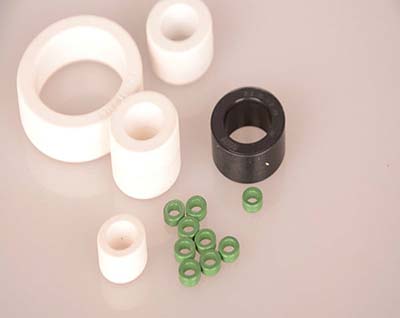400-001-4199
The comparison of amorphous and nanocrystalline alloy
Date:2015-11-04 11:37:00 Hits:
Iron-based amorphous alloy in the field of power frequency and intermediate frequency, is competing with silicon steel. Iron-based amorphous alloy compared to silicon steel, has the following advantages and disadvantages. 1) the iron-based amorphous alloy Bs saturation magnetic flux density is lower than silicon
However, under the same Bm, the wastage of the iron base amorphous alloy is smaller than 3% of the 0.23 mm thick silicon steel. The reason of low loss are usually considered to be a iron base amorphous alloy thin strip thickness, high resistivity. This is just one aspect, the main reason is that more iron base amorphous alloy is amorphous, atomic arrangement is random, there is no atom of orientational magnetocrystalline anisotropy, there is no local deformation and the migration of grain boundary. Therefore, obstruction of domain wall movement and the magnetic moment rotational energy barrier is very small, with unprecedented soft magnetic, so high permeability, small coercive force, low loss. 2) iron base amorphous alloy iron core filling coefficient is 0.84 ~ 0.84 3) base amorphous alloy core work of magnetic flux density of 1.35 T - 1.35 T, silicon steel of 1.6 T ~ 1.7 T. Iron-based amorphous alloy is the weight of the power frequency transformer silicon steel about 130% of the weight of the power frequency transformer. However, even if the weight is heavy, for the same capacity of power frequency transformer, magnetic core adopts the wastage of the iron base amorphous alloy, 70% ~ 80% lower than using silicon steel. 4) considering the loss, the overall evaluating price of 89%
Assuming power frequency transformer load loss (copper loss) are all the same, load rate is 50%. So, to make the power frequency transformer silicon steel iron loss and the iron base amorphous alloy transformer, power frequency, silicon steel is the weight of the iron base amorphous alloy transformer 1? Eight times. As a result, the domestic some identity aside transformer loss level, generally talking about the weight of the iron base amorphous alloy transformer power frequency, cost and price, power frequency transformer silicon steel is 130% ~ 150%, does not meet the requirements of the market principle of cost performance. Abroad put forward two methods of comparison, one is under the condition of depletion of the same, and the two kinds of power frequency transformer used in copper and iron material, weight and price comparison. Another method is to iron base amorphous alloy power frequency transformer loss lower wattage, converted into the currency to compensate. No-load loss converted into 5 ~ 11 dollars per watt, equal to 42 ~ 92 yuan. Per watt converted into load loss $0.7 ~ 1.0, the equivalent of 6 ~ 8.3 yuan. For example a 50 hz, 5 kva single-phase transformer silicon steel core, quotation is RMB 1700 / sets; 28 W, no-load loss at 60 yuan/W, is 1680 yuan. 110 W, load loss at 8 yuan/W, is 880 yuan. Then, the overall evaluating price is RMB 4260 / sets.
Now test the power frequency power transformer magnetic core material loss, is the distortion is less than 2% of the sine voltage. While the actual power grid power frequency distortion is 5%. In this case, the loss of iron base amorphous alloy increased to 106%, the loss of silicon steel up to 123%. If the higher harmonic is large, the distortion of 75% (such as power frequency rectifier transformer), under the condition of iron base amorphous alloy loss increased to 160%, increased to more than 300% loss of silicon steel. That iron base amorphous alloy power waveform distortion resistance is better than silicon. 6) the magnetostrictive coefficient of iron-based amorphous alloy big 3 ~ 5 times of silicon steel.
Therefore, iron base amorphous alloy transformer power frequency noise for silicon steel power frequency transformer noise is undefined
120%, to about 3 ~ 5 db. 7) iron base amorphous alloy strip price is 150% of the 0.23 mm3 % oriented silicon steel
Current market, is 0.15 mm3 % oriented silicon steel (through special processing) is about 40%. 8) iron base amorphous alloy annealing temperature is lower than silicon
Iron-based amorphous alloy annealing temperature is lower than silicon steel, small energy consumption, and iron-based amorphous alloy core generally manufactured by special factory. Silicon steel core transformer factory made in general. According to the above comparison, as long as reached a certain scale of production, iron-based amorphous alloys in the frequency range of electronic transformer will replace part of the silicon steel market. In 400 hz to 10 KHZ frequency range, even with a new type of silicon steel, iron-based amorphous alloys will replace most of the 0.15 mm below the thickness of the silicon steel market. It is worth noting that Japan is vigorously developing FeMB amorphous alloys and nanocrystalline alloy, the Bs can reach 1.7 ~ 1.8 T, and loss of existing amorphous alloys FeSiB is below 50%, if used in electronic transformer, power frequency magnetic flux density is 1.5 T work above, the loss is only 10% ~ 15% of silicon steel power frequency transformer, power frequency transformer silicon steel will be more powerful competitors.
Japan is expected in 2005 can be successfully trial-produced FeMB department of amorphous alloy transformer power frequency, and put into production. In amorphous nanocrystalline alloy in high frequency domain, is competing with soft magnetic ferrite. In 10 KHZ to 50 KHZ electronic transformer, the work of iron-based nanocrystalline alloy magnetic flux density of 0.5 T, loss P0.5 20 k / 25 w/kg or less, therefore, have obvious advantages in the high power electronic transformer. In electronic transformer 50 KHZ to 100 KHZ, iron-based nanocrystalline alloy loss P0.2/100 k is 30 ~ 75 w/kg, iron-based amorphous alloy P0.2/100 k for 30 w/kg, can replace part of ferrite market.

© 2019 www.zjzhaojing.com Zhejiang Zhaojing Electrical Technology Co., Ltd. All Rights Reserved




